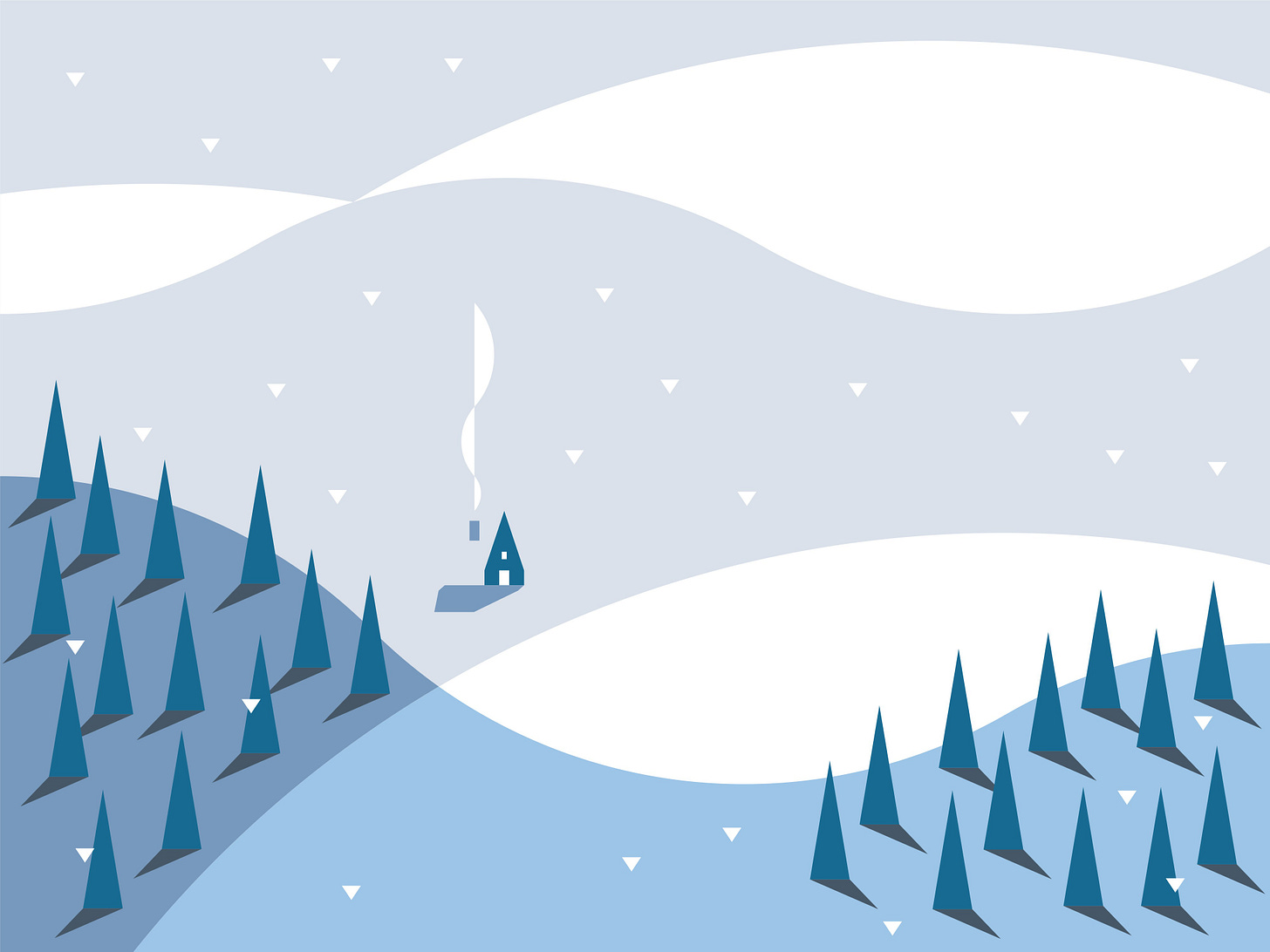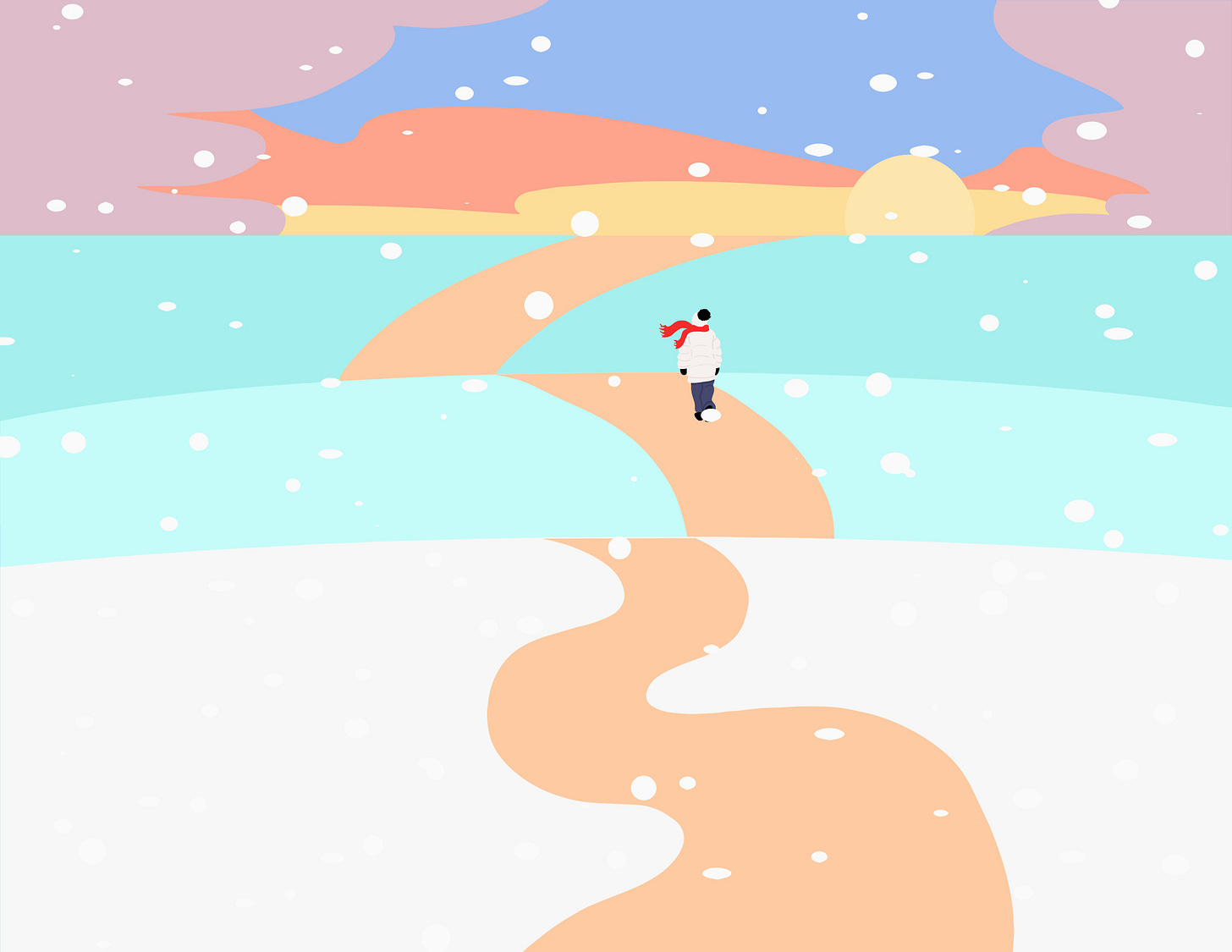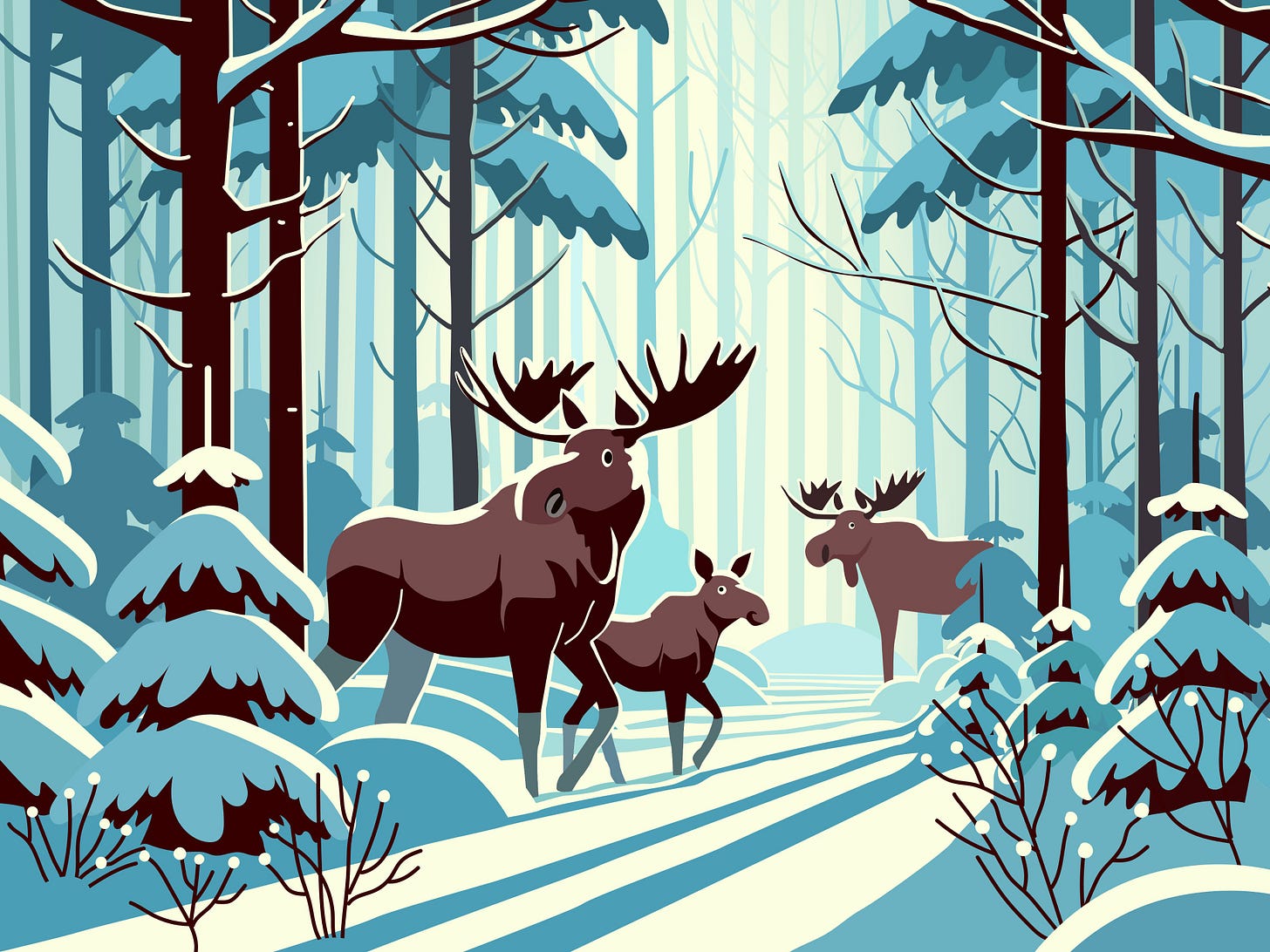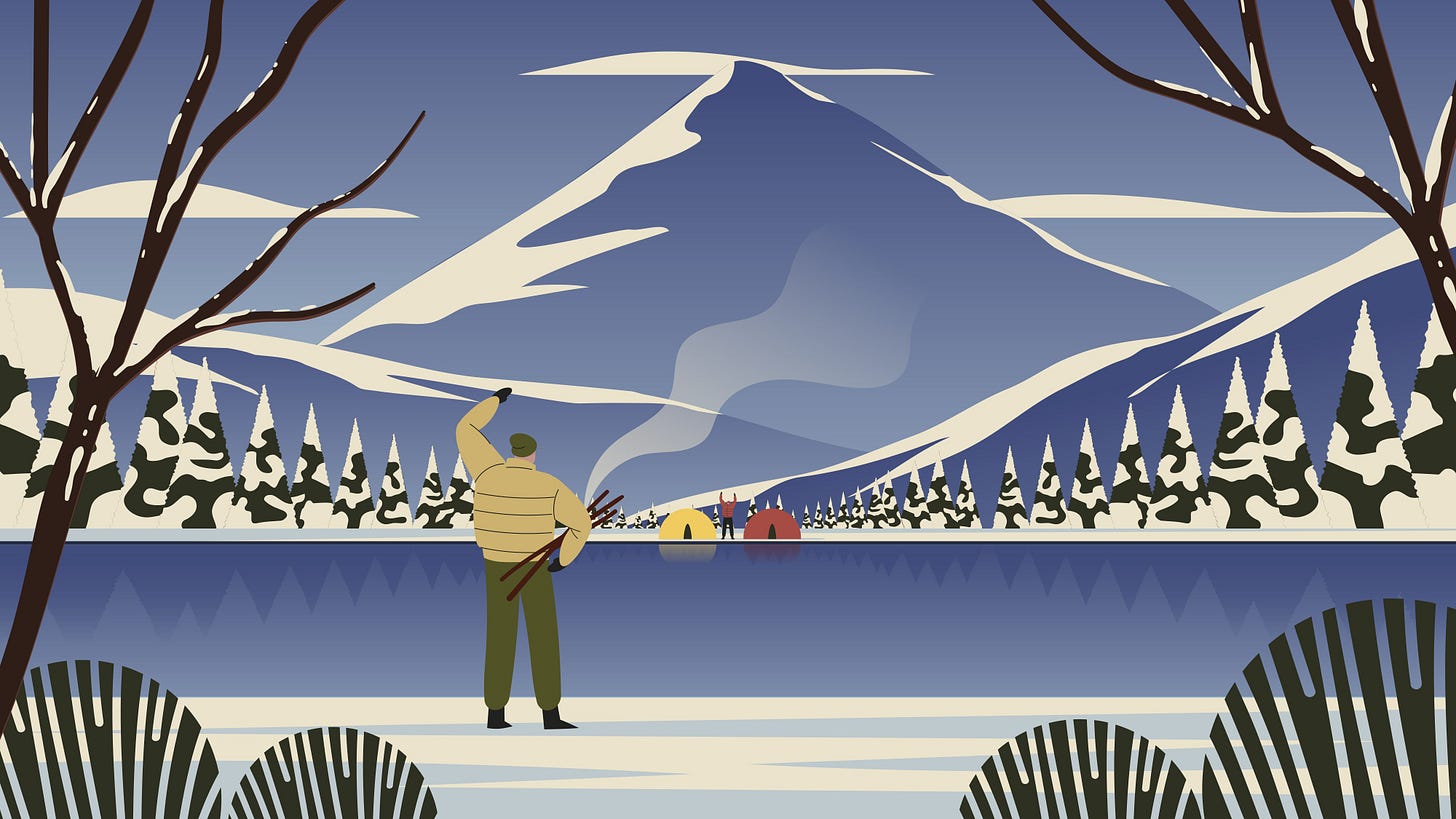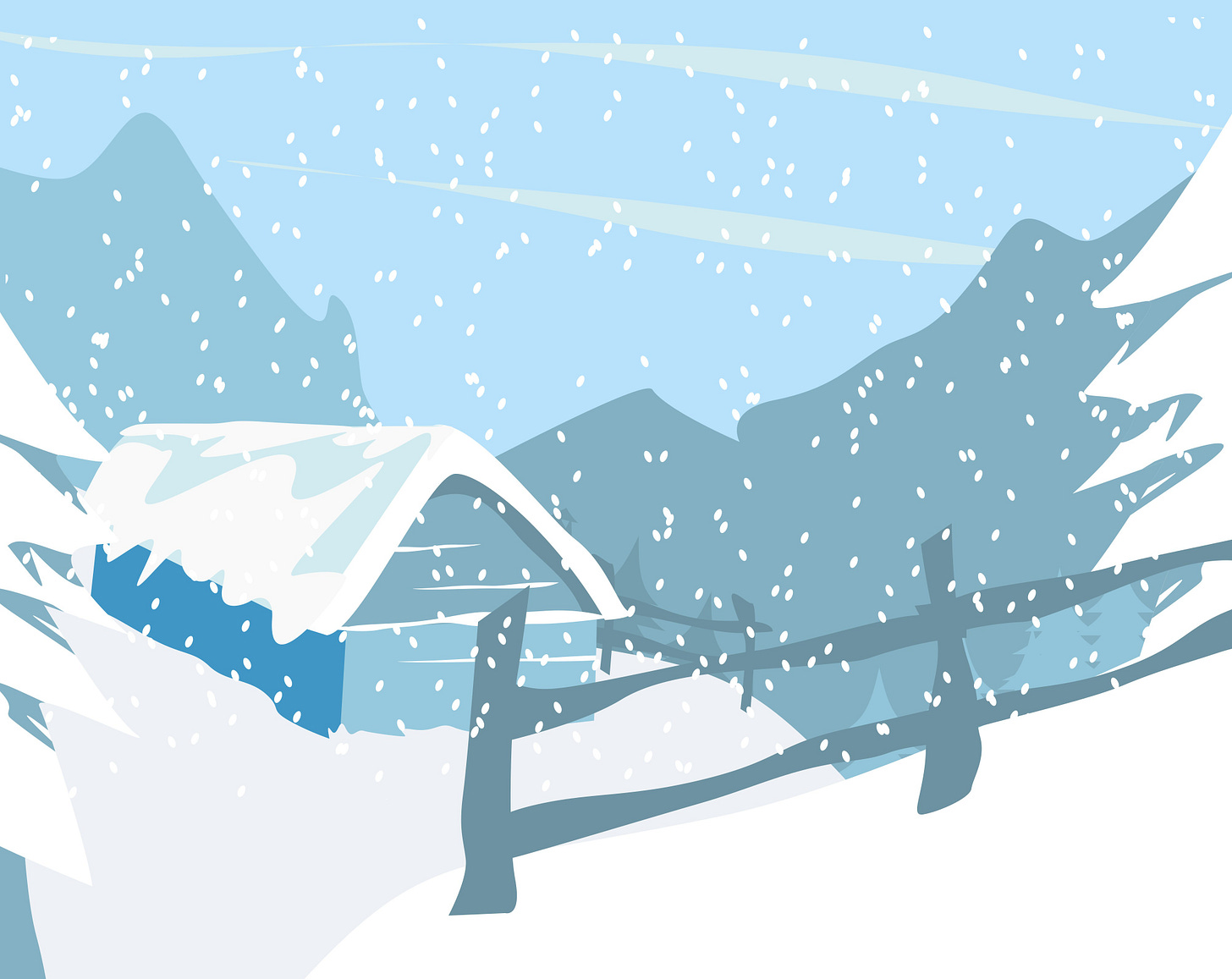Tracks in a Snowy Field
Why writing poetry can save a life
Think of a time when you woke up after a heavy fall of snow.
Maybe you're surprised when pulling back the curtains. The hedge at the end of the garden slumps into smooth new shapes. No paths, roofs along the street no longer tiled, the sky strangely luminous.
There's a new stillness emanating from the severe white scene. A crow flaps away sharpened, rows of graphic poles and wires slice into softness.
What is that feeling you have?
Childish excitement?
Awe?
Bewilderment?
Pleasure?
Putting on your boots, a coat and scarf you push open the door. Bird tracks scrawled across the vanished lawn. Steam rises from your mouth.
It is quiet.
A first step, a squeak of snow under your heel. In the street, tyre tracks, a touch of brown sludge. The air feels chilly as you climb over the fence at the edge of the field. The hill falls away toward trees in the wood. No one came this way today.
You are free to make your mark on the snowy field.
Writers on the edge of a snowy field
This is what it's like as a writer when you sit in front of an empty page. The whiteness is still, but there is a force in the void's severity you can feel. In your mind, you feel a pressure to write, to place some words on the page.
To make tracks.
After writing for a while, I stop and review what I've written. If you are a poet you begin looking for any signs of life. Is there an image you've stumbled across that animates what you're attempting to say?
An image which now lives in the field, among the tracks you've made. This image is alive in a way the other words are not: the image animates the words you strive to breathe into life.
Let’s call them image-creatures. Glyn Maxwell has another take on this, and he writes beautifully about the faum of a poem.
You continue this way for some time. You move backwards and forwards across the field.
Soon, there are a lot of tracks.
You decide to leave the field for the day. Tomorrow will come, and there may be a light dusting of snow. Then, you’ll see the shadow of all the tracks you've made, but you notice where you've trodden more carefully, more fully. There seems to be a pattern to these tracks, a certain uniformity of pacing or conviction.
These tracks lead somewhere, you're not sure where, not yet.
You're pleased to find one or more image-creatures have endured the night. Dusting the snow from their backs, they look back at you, searchingly. You have a feeling of tenderness towards them. They appear to want to help you find what you're looking for. So you approach them, examine the pelt on their back, their shape and size more carefully.
Encouraged, you press on, making tracks a little further down the field. You look back from time to time, and sometimes the image-creatures gesture to other shapes that until then you had neglected to see. They are sisters of the image-creatures and offer you further help.
Soon, you arrive at the edge of the wood and inside, a path leads to a glade. This feels like the place you needed to find. You spend some time looking around, assessing the qualities of this new place. After a while, you leave and return home.
The end of the beginning of a first draft
This is the end of the beginning of a first draft of a poem. In this phase, you have been exploring, looking for a destination and to discover what, if anything, is alive in that place.
When I was in the early stages of mourning for the relationship I had lost, I spent many hours crossing plenty of fields in the snow. Often, I never found the glade I was looking for and returned home, glad for the exercise but unsure if there was anything new that was alive.
From time to time, I found a place I was interested in, curious about. On the way there, I would find a few live image-creatures that seemed at home in that world.
The tracks in the field were a mess however, and with a heavy fall of snow, perhaps over the next week or weeks, the direction in which they led might be lost.
What I needed now was a map, clear directions and a way to remember both the way there and what I'd seen.
Building a map and directions and a way to remember them is the work the poet does to move the tracks of a first draft into a stable form.
There are new questions I ask myself now.
Was I running across the field? Or was the way there circuitous and leisurely?
Were the creature-images I found at home in a quiet, reflective environment, or something more disquieting, combustible or fragmentary?
What was the light like in that field? Sunset, sunrise, grey and flat or piercingly blue?
Was it windy with clouds flinging the shade around?
Did this place feel surprising and unexpected, or did it feel familiar?
How will I remember the way there?
How will I invite other people to explore this space?
And how will I help them remember the way?
These questions and more make up the work of editing the poem for memorability, stability and to ensure the image-creatures have somewhere they will feel at home.
Setting the way into memory
We have moved from exploration to setting the way into memory. Finding the right form for a poem is not always straightforward, and I will experiment with several potential habitats (forms) for the image-creatures. I'll listen for signs from the image-creatures about whether they feel happy and alive in any of them.
When I'm editing a poem at this stage in its journey to something (hopefully) memorable, I lean on the forms poets discovered over the centuries as they walked into their own snowy fields.
Any form is in a wrestling match with two elements in the poem. The snowy field and the tracks we make on the snowy field.
Some poems require more snow to be left untouched. Others long for fence posts and a sense of containment. We often need containment; the snowy field is one field within a vast universe of snow.
The vastness is not inert because it is endless. Anything that is endless is outside of a mortal realm. For us to grapple with infinity (death), we erect our corrals and our stables and our farmyards. In these confined spaces, we build something we can call home.
Using a strict form, one that has rules, (like a sonnet for instance), forces us to pay attention to the fences. If there are any rules in poetry, they are surely about writing memorably. Centuries of effort and craft have refined forms compatible with embedding poetry in the human heart.
Rhyme, rhythm and metre, stanza length, line breaks, among many more, are the poetic memorability codes poets learn to use.
Form and self-healing
In the depths of sadness and despair, I would walk out into those snowy fields regularly. Making tracks helped me to confirm I was still here, and to show, if only to myself at first, I was still interested in purpose and meaning.
There was a certain therapeutic value to this work, based simply on letting out whatever was there inside. I allowed all the hurt and confusion to lead me over the snowy field.
The real value of a poetry practice to me in the heat of my despair was when I started to make sense of the tracks I'd made by using form. Form enabled me to regulate the wild, emotional energy, partially confining or containing it. Then I was no longer overwhelmed, and it was easier to make sense of where the tracks lead, and what the glade in the wood meant.
Form helped me to distance myself from the power of the emotions I was feeling. The best way I can describe this is to compare this to Chernobyl.
The reactor cores melted and, from the shattered and broken reactor house, lethal radiation pours into the air. To approach it directly is dangerous, and likely to be toxic.
I must build a shield and then a container to approach the fire's source more safely.
Certainly, if I am inviting anyone else to approach the inferno, I have a responsibility to lead them to a room with a safe observation window.
Poetry, Purpose and Meaning
Writing poetry in the midst of despair or other distressing human condition, is partly about honouring what it means to be human. Being human means being in a relationship with time.
Some philosophers (e.g. Heidigger) believe that the source of all discontent and unhappiness is the awareness of our own mortaility. As we know our time is finite, they argue, any loss of purpose or meaning has an existential quality.
Writing poetry helps to derive meaning from our suffering. This is what all artists do, and poetry is no different. By reflecting on our discontents and translating the emotional and intellectual landscapes (snowy fields) into something beautiful and memorable, is meaningful and the attempt to do is purposeful.
There are stages in most lives when the purpose and meaning of a life can be questioned. In those moments, it can be useful to turn (or return) to a writing practice and walk out into the snowy field.


